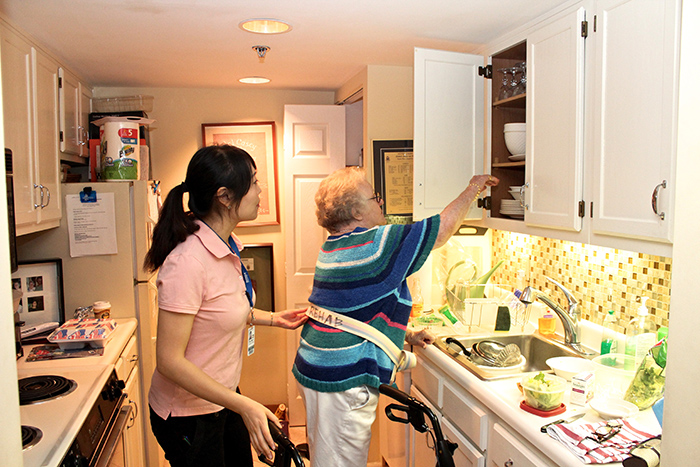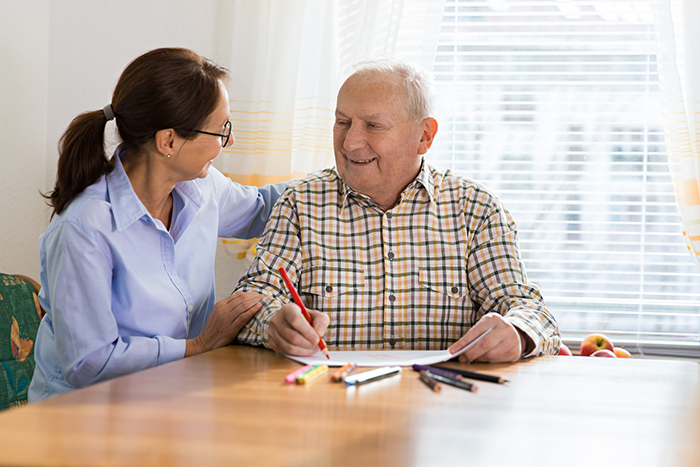Home modifications & key community partnerships
Successful and safe home management is key to daily living across the life span. Occupational therapy has long appreciated the interplay of environmental factors as barriers or facilitators to occupational performance. Assessing and modifying the home environment offers hope to sustain individuals' quality of life through active participation in their preferred contexts. The skills and contributions of occupational therapy are increasingly recognized as experts in this area, reflecting our ongoing partnership with Re-building Together and various community based funding opportunities.
Innovative approach to community-based practice
Home repairs and modifications to enable aging in place are most effective when occupational therapy practitioners play a central role on the home modification team. For over 20 years, the American Occupational Therapy Association (AOTA), and the national home repair nonprofit, Rebuilding Together, have been active partners. Working together we seek to advance home modification programming across the country that includes evidence-based practice strategies and evolve services to integrate occupational therapy practitioners when possible.
Since the inception of the Safe at Home program and the launch of the Rebuilding Together and AOTA partnership in 2001, Rebuilding Together affiliate leaders are increasingly aware of the distinct value of occupational therapy practitioners on the home modification team. The partnership between occupational therapy practitioners, construction staff, and volunteers has proven to be beneficial for all parties and the communities being served.
Using extensive construction expertise, Rebuilding Together affiliate leaders provide safe and healthy housing repairs and modifications such as:
- Fixing electrical hazards.
- Addressing active water leaks and moisture problems.
- Installing grab bars and wheelchair ramps
- Improving ventilation.
What roles does OT play in home modifications?

Occupational therapy practitioners often play an important role by providing home modification recommendations based on homeowner needs, functional status, interests, and goals. In addition to initial recommendations, occupational therapy practitioners often return after the home modifications are complete to provide consultation for proper fit, adaptive equipment training, and falls prevention strategies.
Making the right connections

Occupational therapy academic programs also provide a natural connection for occupational therapy practitioners and Rebuilding Together partnerships. Students and faculty are in need of hands-on, direct experience in the community and affiliates are in need of help with home assessments, home modification recommendations, and program improvements. Partnerships between local affiliates and occupational therapy faculty leadership have demonstrated great success.
Rebuilding Together impacts student experience
As an example, Rebuilding Together Philadelphia partners with faculty at Salus University to involve occupational therapy fieldwork students each semester as part of Level I and II fieldwork experiences. Students work with their faculty supervisor to complete home assessments and follow up visits to deliver adaptive equipment and client-centered training. Community outreach from the partnership has expanded to providing community education classes for older adults who wish to age in place. Students learn valuable skills such as effective client interactions including cultural humility, as well as how to perform a client-centered assessment to provide sustainable and impactful recommendations to support client safety, comfort, and independence.

Key AOTA partnerships
Rebuilding Together
Rebuilding Together is a national organization that preserves and revitalizes houses and communities through more than 170 local affiliates nationwide. Nearly 10,000 homes are repaired and rehabilitated by volunteers each year. AOTA and Rebuilding Together work toward mutual goals of raising visibility, actively participating in communities, and promoting home safety and independence. Occupational therapy and Rebuilding Together are natural partners as we strive to optimize the fit and function of homes. Occupational therapy clinicians, educators, and students across the country have consulted on Rebuilding Together projects to improve lighting, remove obstacles, install adaptive equipment, and recommend other strategies to make homes safer and more accessible.
National Council on Aging – Center for Healthy Aging
NCOA collaborates with AOTA routinely on a variety of programs to address the needs of older adults in the community. Through collaborations around falls prevention the role for occupational therapy in home modifications has been amplified.
USC Leonard Davis School of Gerontology
AOTA is proud to partner with both USC and NCOA on the National Home Safety and Home Modification National Work Group to implement the National Falls Prevention Plan from 2015.
Centers for Disease Control and Prevention (CDC)
In addition to recommending referral to occupational therapy to assess for home hazards in the STEADI (Stopping Elderly Accidental Death and Injury) algorithm for falls prevention, the CDC National Center for Injury Prevention has a Preventing Falls Among Older Adults Web site section that includes fact sheets, graphs, brochures, and a home safety checklist about falls and fall prevention.
Explore these additional partners for home modifications resources

AARP – Livable Communities and HomeFit Guide
Gerontological Society of America
International Council on Active Aging
National Center for Healthy Housing
National Resource Center on Supportive Housing and Home Modification
The National Safety Council Resources on Home and Community Safety
Discover paths for home modification certification.
Explore these options for certifications in home modifications.
Executive Certificate in Home Modification through USC – Leonard Davis School of Gerontology
Certified Aging in Place Specialist (CAPS) through National Association of Home Builders (NAHB)
Certified Living in Place Professional through Living in Place Institute
Key partnerships and community-based innovations will be critical for occupational therapy to address the needs of older adults through home modifications.